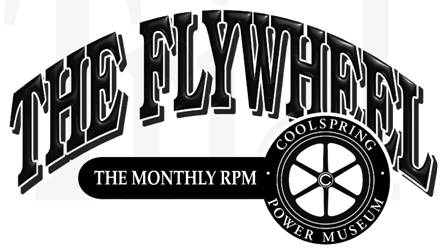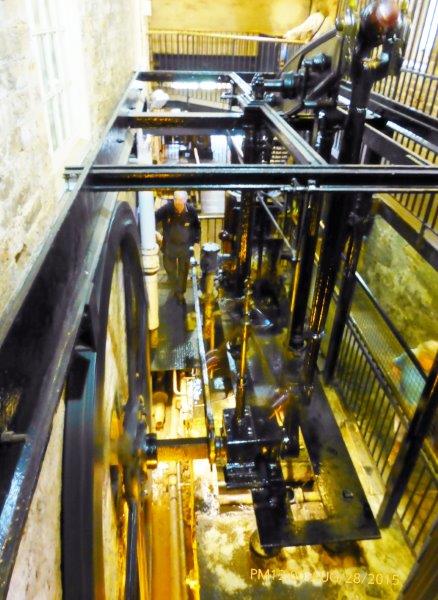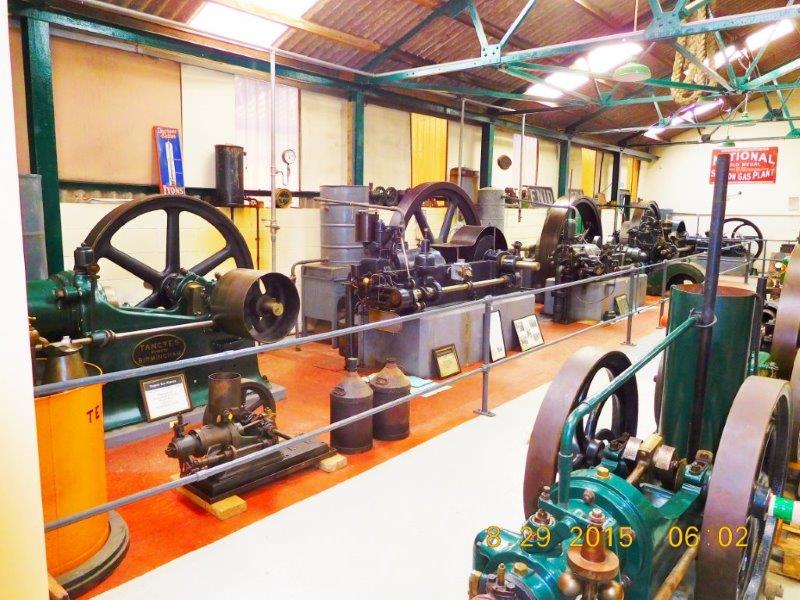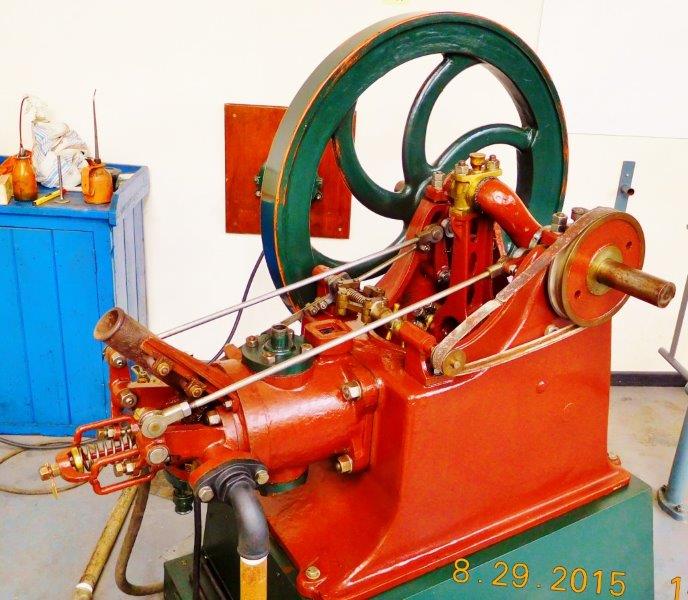|

March 2016
A Visit to England
By Paul Harvey

Tom and the Crossley at the Museum
of Science and Industry in Manchester
Inspired by the Coolspring Power Museum's
most successful Thirtieth Anniversary Show in June of 2015, and with so
many of the international visitors enticing me to visit them, I decided
to make it a reality. With my good friend, Tom Rapp, we decided to go to
England and see some of their marvelous
museums. I did have an additional motive for this visit. My
grandfather immigrated from Scotland
in 1872, and, having done research on Ancestry.com, I had discovered
that the Harveys always
resided in Stirling,
Scotland. So the venture was to be to
find traces of my family, then to see some great engines.
We left from
Pittsburgh on Friday evening, August 21, and
arrived at Edinburgh,
Scotland, the next morning. After
walking through old town Edinburgh, we had a great dinner at the Steak
and Mussel Bar, then dropped into bed. The next morning we took the
train to Stirling, and the adventure began!
Stirling is a
beautiful little medieval city about 40 miles northwest of
Edinburgh, located on the winding River Forth.
We stayed at the Portcullis, a little inn built in the 1700s. From
there we had a great view of the castle, the church, and the quaint
city. Pondering what to do first, we chose to walk to the huge Church
of the Holy Rude, Rude being a Scottish word for a relic from the
cross. The church is shown in Photo 1. Built about 1,000
years ago, John Knox, who converted
Scotland from Catholicism to the
Presbyterian faith, actually preached here in the 1500s. After
wandering about the church in awe, I asked one of the docents if any
Harveys were buried here. He smiled, disappeared
a moment, then returned with a huge old ledger. Jotting down some
entries, he said, "Come along and I will show you." Walking out into
the kirkyard - Scottish for churchyard - he showed Tom and me all my
ancestors graves! Photo 2 is the main
Harvey marker, dating back into the early
1700s. After a great day, we had an excellent dinner at our inn and
were thrilled to see this night view of the
Stirling Castle
from our window, as shown in Photo 3.
On the morning of August 26, Tom and I
departed from Stirling for a 6-hour train ride to
Manchester, England.
The scenery was superb, gradually changing from the small, bleak
Scottish farms into the lush and expansive English farm land. Finally
the view became suburban as we neared our destination of
Manchester. Arriving, we walked to our hotel,
then toured the city a bit before a good dinner and turning in for the
night.
Next morning, we were at the
Museum of
Science and Industry in Manchester before the doors opened. Perhaps the
most wonderful museum that I have ever seen, it is the redeveloped old
Great Western Railway warehouse complex. It is huge!!! Photo 4
shows the entrance to one of the buildings. Entering Power
Hall, a huge brick warehouse building, Tom and I headed for the
engines. First in line is a Crossley built Otto and Langen, shown in
Photo 5. Looking beyond, we were awed by the engine row
shown in Photo 6.
The museum is massive, with many
buildings, so our one nine-hour day barely scratched the surface. Due
to limited space, I cannot begin to show all the great exhibits. I
think of note is Photo 7, a Mirrlees air injection diesel
that actually runs. I was especially fond of this huge National engine
driving a generator. See Photo 8. All panel boards and
wiring are complete and operate when the engine runs. There are steam
engines, locomotives, vehicles and aircraft, as well as buildings
dedicated to gas and electricity. It's all there!
Manchester is a pleasant old industrial city, and
this museum is definitely a "must see" on any visit there.
Departing Manchester
the next day, we rented a car and drove to our inn for the rest of our
stay. Glad to have the quiet rural roads, I finally became a bit
comfortable driving on the left side. We soon arrived at the Deanwater,
our inn, which is located in a quaint wooded setting along the River
Dean. It was originally a hunt club built in the 1700s. With a few free
hours before dinner at the inn, we decided to explore the area.
We chose to drive several miles to
Quarry
Bank Mill, Photo 9, which is a massive cotton mill built
in 1784. Restored and operated by the National Trust, it spins a story
of textile making that ends in the mid-twentieth century. Originally
powered by "the most powerful waterwheel in Europe,"
we watched it turn at two revolutions per minute. At 32 feet in
diameter and 21 feet wide, it slowly rotated to produce 1,000
horsepower. The ancient gears groaned while turning a vertical shaft
that operated the looms on the floors above. Photo 10
shows a spinning demonstration that produced the cotton thread for the
looms to weave into fabric. By 1810, the mill management realized that
many summers produced a shortage of water from the river, shutting down
the entire operation. The answer was to install a boiler and a Boulton
and Watt steam beam engine. It is shown in Photo 11
operating under live steam. All the other steam engines used to
maintain the mill were also operating. At dinner Tom and I reflected
that the Quarry Bank Mill was an impressive tour, and then looked
forward to seeing the
Anson
Engine Museum
the next day.
After a good breakfast at the Deanwater,
Tom and I were anxious to visit Anson, sometimes called, "the Coolspring
of England". Actually this visit was one of our main objectives of our
trip, and we were not disappointed. We spent the next three days there!
Driving through the old village
of Poynton, we soon turned
into the wooded driveway of the museum. After parking our car, we
walked to the main entrance to the museum, seen in Photo 12.
Entering, we were greeted by familiar faces of friends we had made
in June. After chatting a bit, we proceeded into a most wonderful and
amazing world of engines!
Upon entering the next room, Tom and I
were in awe to see Crossley Number 1. This is the first gas engine that
Crossley Brothers, from nearby Manchester,
built. Crossley had obtained the English license to build the
German-designed Otto and Langen free piston engine. It is shown in
Photo 13. Walking further into the next large area, we were
greeted with the great engine display pictured in Photo 14.
All the large engines to the left operate.
Photo 15 shows Geoff
Challinor, Curator of Anson, adjusting the starting torches on the very
complicated and unusual four-cylinder Gardner
oil engine. Geoff actually uses a timer to keep the torch sequence
according to the book. Finally he turned on the starting air, and the
beast sprang to life. With a few more adjustments, it was humming
happily and driving a generator to provide brilliant lighting to the
area. Touring on, we met Pat, a very helpful docent who posed beside
the air injection Mirrlees diesel, serial number one. Note Photo
16. This is the oldest Diesel engine in the
United Kingdom. It is interesting to
note that Pat spent his entire career working for Mirrlees.
A very odd engine is seen in Photo
17. This is an Atkinson engine that is amazing to see run.
With its unusual toggle linkage, it provided two strokes of the piston,
of different lengths, per one revolution of the crankshaft. By
incorporating this feature, it circumvented several patents and was
fairly successful.
Probably my favorite engine of the
Anson Museum
is the huge three horsepower Crossley free piston engine. I am dwarfed
standing beside it as seen in Photo 18. Built in 1877, it
was the largest model produced. It was used in the upper story of a
warehouse to drive a winch and jib crane that unloaded tar barrels from
barges. Affectionately known as the "Rattling Monster," it still
happily operates its original hoist. In awe, I watched it "rattle" many
times during my visit.
One of the oldest engines at Anson is the
Hugon, shown in Photo 19. It was built in
London in 1867 under the Hugon patents. Rated
at 1/2 horsepower, it is number 21. It is a non-compressing,
double-acting engine very similar to the Lenoir. The final engine shown
here is this big two-cycle Vickers, seen in Photo 20. It
certainly sports a huge flywheel and ran very smoothly.
It operated each day.
The three days of our Anson visit went
very quickly. There are so many other engines that I wished to have
been able to show, but, with space restrictions, I must stop here.
Anson is certainly a "must see" for any engine enthusiast visiting
England!
The next morning, Tom and I drove to the
Manchester airport, returned our car, and were
soon home. It was a great visit, and I hope to return again soon!

Photos by Tom and Paul
Returning to Coolspring next month, I
will feature our "Gus" engine. It promises to be an interesting story.
Cheers!
|






















